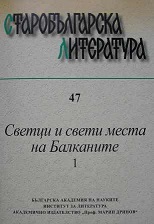Јужнословенски пустињаци Х–ХІІІ века у најстаријој литерарној традицији
South-Slavic Hermits from the Tenth to the Thirteenth Centuries in the Oldest Literary Tradition
Author(s): Irena ŠpadijerSubject(s): Language studies
Published by: Институт за литература - БАН
Summary/Abstract: A number of anachoretic cults were created in the period from the second half of the tenth century up to the end of twelfth century, in the region between Rila and Kosovo. It was in this region, defined as the authentic hub of South-Slavic literature, where Slavic hermits lived as early as the tenth and eleventh centuries. Both written records and oral tradition about their lives date back to a very distant past. The cults of the hermits who were proclaimed saints - St John of Rila (who died in 946), St Prochorus of Pčinja (the 11th c.), St Gabriel of Lesnovo (the 11th c.) and St Joachim of Osogovo (the 11th -12th c.), as well as St. Peter of Korisha (the 12th, possibly the early 13th c.) - were established very early. Some texts dedicated to these anchorets were definitely written soon after their death, as by the end of the 13th century there were already witnesses in the written tradition – namely, vitae of St John of Rila, St Gabriel of Lesnovo and St Prochorus of Pčinja), as well as church services dedicated to St. John of Rila and St. John of Osogovo. The earliest works on St. Peter of Korisha also belong to the thirtheenth-century literary tradi-tion. This paper looks at the oldest texts dedicated to these South Slavic hermits and analyses their inter-relations.
Journal: Старобългарска литература
- Issue Year: 2013
- Issue No: 47
- Page Range: 108-120
- Page Count: 13
- Language: Serbian
- Content File-PDF

